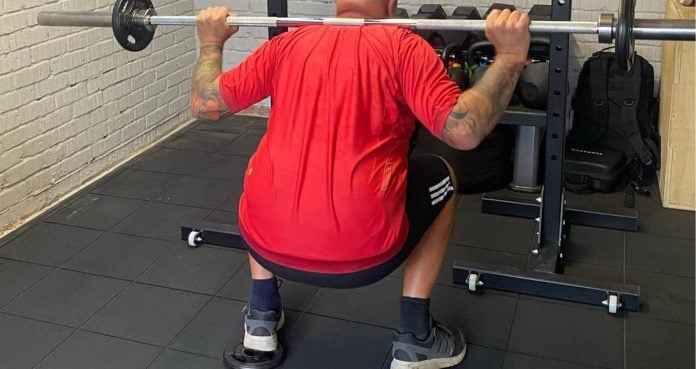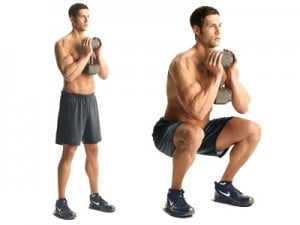
Elevating your heels during a squat yield more quad activation.
Squats are a seamless part of your daily routine, often performed without conscious effort, especially if you don’t experience lower back pain. When sitting down or getting into your car, you do some form of squatting. Consequently, squats are renowned as functional exercises integrated consistently into our daily movements. Therefore, incorporating squats, such as goblet squats can help you with everyday life.
Squats are great lower-body exercises and target your core, thighs, and legs. There are many ways to vary your squats, and you can also add some resistance using barbells, dumbbells, or kettlebells. However, sometimes all you need to do is tweak this routine by changing the position of your body part; for this exercise, that part is the heel.
As the name implies, the squat with heel raise is doing a squat with your heels higher than the floor. Another name for this routine is the heel-elevated squat, which offers many benefits. The exercise is quite popular, and there’s a chance you’ve seen an athlete at your gym doing it.
But how do you do a squat with heel raise? Is it an exercise where you’re on your tippy toes with your heels in the air while you play a balancing act like an acrobat? In this guide, we share the exact form for this routine, its many benefits, and some useful alternatives similar to this exercise.
Techniques and Muscles Worked
A squat with heel raise targets all the muscles your regular squat does. These are the hamstrings, glutes, quads, abductors, adductors, rhomboids, abs, obliques, and traps. Raising the heels, however, increases the activation of your quads and calves, as this 2022 study shows (1).
When doing heel raises, you can either use weight plates to elevate your heels or do so using wedges. Weightlifting shoes also do the same thing since they slightly elevate their heel. The best weight plate to use is two 5lb barbell weights under each heel. Here’s a step-by-step guide on the proper way to do this exercise.
- If using a barbell for your squat with heel raise, add the appropriate weight to the barbell and unrack it. Place it behind your head so your shoulder and traps carry the weight.
- Stand with your heels on the weight plates with your feet hip-width apart and your toes facing out slightly. Brace your core and keep your torso upright. This is your starting position.
- Keeping your back neutral, bend at your knees while pushing your hips down until your thighs are parallel to the floor, then pause.
- Pressing into your heel, push your hips upwards, and rise to return to starting position and complete your rep.
Note: Some people might want to perform step two first before adding the weight of the barbell. This is useful if you’re lifting heavy, as getting the proper stance with the barbell on you could be hard.
Benefits
The squat with heel raise is a powerful variation of the regular barbell squat and offers many advantages. Below are some of these important benefits.
Increased Range of Motion
Elevating your heels when squatting increases the range of motion at your knees. As a result, it also increases the distance your hips move during this exercise. This puts your muscle under tension for longer, leading to greater muscle fiber activation in the leg muscles.
Deeper Squats
Squat depth is important for muscle building and strengthening. The deeper your squat, the better the muscle growth in your hamstrings, quads, and glutes (2). The full range of motion that elevating your heels during the squat with heel raise gives you leads to a deeper squat.
Increased Quad Activation
Elevated heel squats also lead to greater quad activation than flat-footed squats. Because as your heels are raised, your knees go over your toes when you squat, making your quads work harder. The vastus medialis, in particular, get lots of activation, and this is important for bodybuilders as other common leg exercises don’t activate that muscle directly.
Less Lower Back Stress
Squats like the ass-to-grass squat with a deep range of motion put lots of stress on your lower back. If you slightly take your knees over your toes, you could have a sore lower back even when doing regular squats. With the squat with heel raise, your hips go down, which relieves tension from your spine and lower back (3).
Easier On Hips and Ankles
Squats with heel raises are efficient and put less stress on your hips and ankles. You can still do this exercise with limited hip flexibility and ankle mobility. The elevation of your heels moves your knees at an angle that reduces the total range of motion needed at your hip.
Squat with Heel Raise Alternatives
Do you love the benefits that this exercise offers? Then some more routines focus on similar muscles and offer great benefits too.
Goblet Squat With Heel Raise
Goblet squats with heel raise are also great for your quads. With goblet squats, you’ll be better able to focus on keeping your torso upright and building your quads, as there’ll be no barbell weight to balance. Goblet squats are also great for core activation.
High Back Bar Squat
With a high back bar squat, you also require less ankle mobility than regular squats because the bar rests higher on your back. This position could also be more uncomfortable.
Hindu Squat
Hindu squats are great for the upper, mid, and lower body. This exercise builds your shoulders, core, glutes, hip flexors, quads, hamstrings, calves, and ankles.
Cyclist Squat
The cyclist squat is like the squat with heel raise but has your feet closer together. This lifts your heels a bit higher and builds your quads even more.
FAQs
What does squatting with your heels raised do?
Squatting with your heels raised will do a lot for quads and glutes. This exercise is also easier for those with lower back pain.
Does lifting your heels while squatting matter?
Lifting your heels while squatting will push your knees over your toes and make your quads more involved. This increases muscle growth in the quads.
What do heel-elevated front squats work?
Heel-elevated front squats work the same muscles that regular squats build. However, more emphasis is placed on your quads with this routine.
Follow us on Instagram, Facebook, and Twitter for more exercise guides!
References
- Lu, Z., Li, X., Xuan, R., Song, Y., Bíró, I., Liang, M., & Gu, Y. (2022). Effect of Heel Lift Insoles on Lower Extremity Muscle Activation and Joint Work during Barbell Squats. Bioengineering (Basel, Switzerland), 9(7), 301. https://doi.org/10.3390/bioengineering9070301
- O’Neill, K. E., & Psycharakis, S. G. (2021). The effect of back squat depth and load on lower body muscle activity in group exercise participants. Sports biomechanics, 1–12. Advance online publication. https://doi.org/10.1080/14763141.2021.1875034
- Sayers, M. G. L., Bachem, C., Schütz, P., Taylor, W. R., List, R., Lorenzetti, S., & Nasab, S. H. H. (2020). The effect of elevating the heels on spinal kinematics and kinetics during the back squat in trained and novice weight trainers. Journal of sports sciences, 38(9), 1000–1008. https://doi.org/10.1080/02640414.2020.1738675
















